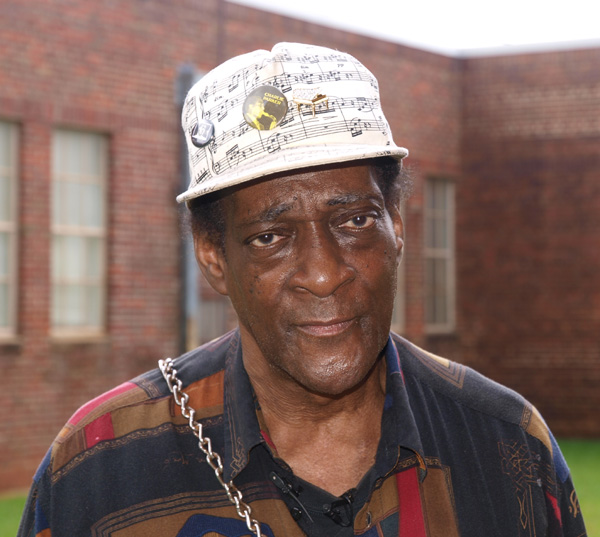
Remembering Omar Sharriff
(born March 10, 1938, died January 8, 2012)
by John Tennison, M.D. Originally published on April 6, 2012 (Updated on Novembe 18, 2015)
This web page is a compilation of some of the materials that I have collected that pertain to the late Omar Sharriff.
Omar Sharriff was born March, 10, 1938 in Shreveport, Louisiana. The 1940 U. S. Census shows Omar (then known as David Elam) living with his family at age 2 at the street address of 2128 Marion Street in Shreveport, Louisiana. The 1940 census indicates that Omar's father, Tommy; mother, Susy; and 6-month old brother, Donald were also living at that same address in Shreveport at the time of the 1940 U.S. census. The 1940 U. S. Census indicates both of Omar's parents as having been born in Louisiana. However, this is possibly in error, as another document suggests that Omar's father, Tom Elam (AKA Tommy Elam), was born in Tatum, Texas, in 1893. Moreover, the 1940 U. S. Census indicates that Tommy Elam was 45 years old, but gives a birth year of "about 1895," suggesting that even at the time the census was taken, the census taker was expressing uncertainty about the birth year of Tommy Elam, which would also imply uncertainty about Tommy Elam's age. Consequently, at this time, I will express the birth year of Tom Elam (AKA Tommy Elam) as "circa 1893-1895."
After the 1940 U.S. Census was taken, Omar's family moved to a rural community in Harrison County Texas, just outside and south of Marshall and on the east side of Highway 59. Omar attended elementary school in this community before his family moved within the Marshall city limits, where Omar attended Pemberton High School. After being away from Marshall for many years, Omar Sharriff moved back to Marshall, Texas in 2011, where he lived for almost a year before his death on January 8, 2012.
Contemporary Keyboard Magazine First Annual Readers' Poll
In the first-ever Readers' Poll results, published on page 25 of the January, 1977 issue of Contemporary Keyboard magazine (later known as Keyboard Magazine), Omar Sharriff (then known as Dave Alexander) was ranked 2nd only to Ray Charles as the greatest living blues pianist. It is noteworthy to point out that Dave Alexander was ranked above other great living blues pianists at the time, including Professor Longhair (3rd place) , Memphis Slim (4th place) , Champion Jack Dupree (tied for 5th place), and Piano Red (tied for 5th place).
Omar Sharriff (AKA David Alexander Elam) at Pemberton High School (his alma mater) in Marshall Texas on June 11, 2010

photo by John Tennison, MD
A memorial tribute ceremony for Mr. Sharriff was held at 1:00 pm on Saturday, January 14, 2012 at the Marshall Convention Center (AKA Civic Center), 2501 East End Blvd., Marshall, Texas 75670. Following the memorial ceremony, a burial ceremony was conducted at Algoma Cemetery in Marshall, Texas.
The location of Sharriff's gravesite is at the tip of the red arrows in the two images below:
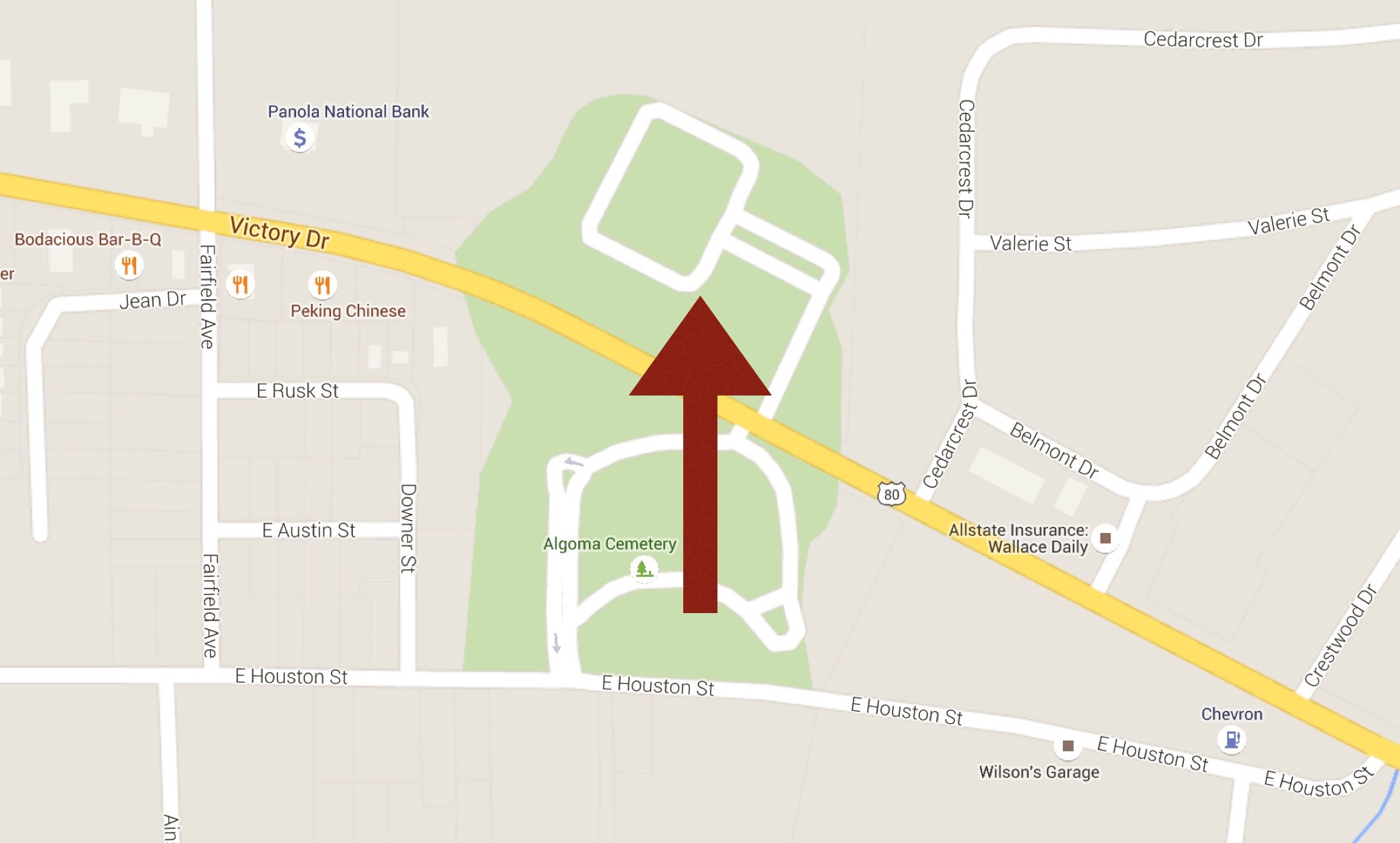
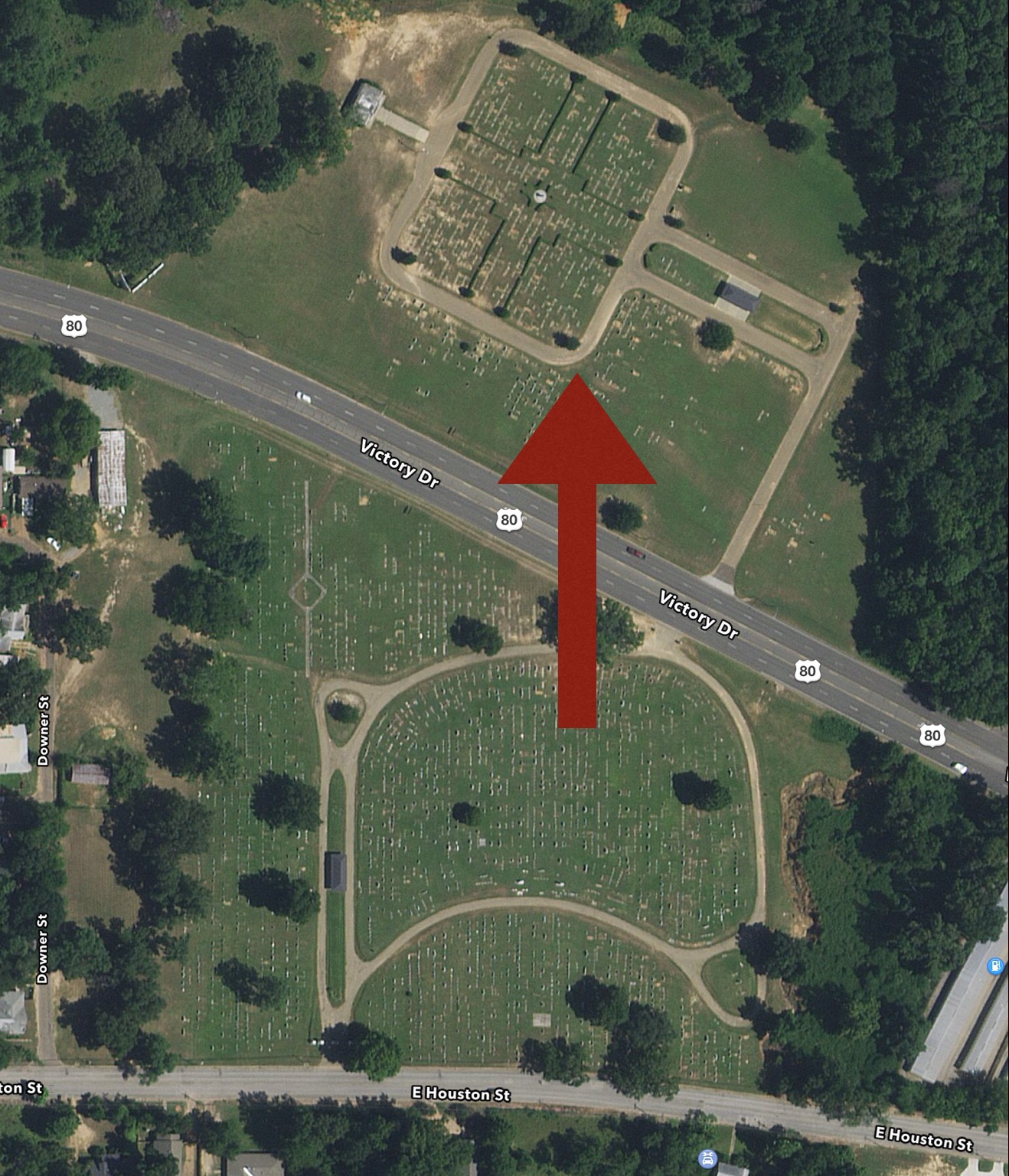
On Sunday, October 11, 2015, Ezra Charles performed a benefit Boogie Woogie concert to raise funds for Omar Sharriff's headstone.
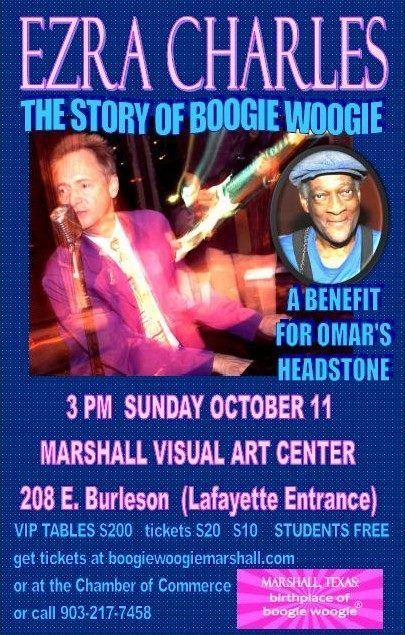
At the Boogie Woogie benefit concert by Ezra Charles on Sunday, October 11, 2015, John Tennison made the following Introductory Comments:
Introductory Comments for Ezra Charles Benefit Concert for Omar’s
Headstone
by John Tennison, October 11, 2015
Thank you, Jack and Nancy
Canson.
And thank you, Ezra Charles and Jakob Helpinstill, for bringing
your musical talents to Marshall, Texas. Your presence here today is evidence
that Boogie Woogie is alive and well in Marshall.
Also, thank you,
Melinda Gaulden; the Meadowbrook Funeral Home; and to everyone here today for
their support for a headstone that will properly memorialize Omar Sharriff and
his music.
So how did I get here?
I was born in 1968 in Texarkana,
Texas. I grew up playing Boogie Woogie, but not until the fall of 1985, during
my senior year of high school, did I began researching the history of Boogie
Woogie.
Before going off to college at Johns Hopkins in Baltimore, MD, I
began to interview Texarkanians about the history of Boogie Woogie. One of these
interviews was with Lee Ree Sullivan during the summer of 1986. Prior to my
interview of Lee Ree Sullivan in the summer of 1986, I had relied on Lee Ree
solely as a teacher of Boogie Woogie, rather than as a source of knowledge about
the history of Boogie Woogie.
Although I did not fully appreciate its
significance at the time, the first time I heard the word “Marshall” in
relationship to Boogie Woogie was during my interview of Lee Ree Sullivan in the
summer of 1986.
Lee Ree cited the names of 12 specific Boogie Woogie bass
figures that he had been taught by local Texarkana Boogie Woogie players. Lee
Ree said that he had been told that all 12 of these bass figures came into use
in the context of Boogie Woogie at locations for which they were named.
One of these 12 Boogie Woogie bass figures is the “Marshall.” This fact and
other attributes of Marshall, Texas in the early 1870s resulted in my starting
to call Marshall “The Birthplace of Boogie Woogie.”
Upon hearing about my
research on Boogie Woogie, city leaders in Marshall arranged for me to present
my research on January 18, 2010 in Marshall.
On that same day, I pointed
out to people in Marshall that there was a musician living in California who had
grown up in Marshall; and who was highly regarded as a Boogie Woogie and Blues
musician. This person was Omar Sharriff, who was born March 10, 1938, and who
grew up in Marshall as David Alexander Elam.
Indeed, in the first-ever
Readers' Poll results, published on page 25 of the January, 1977 issue of
Contemporary Keyboard magazine (later known as Keyboard Magazine), Omar Sharriff
(then known as Dave Alexander) was ranked 2nd only to Ray Charles as the
greatest living blues pianist. It is noteworthy to point out that Dave Alexander
was ranked above other great living blues pianists at the time, including
Professor Longhair (3rd place), Memphis Slim (4th place), Champion Jack Dupree
(tied for 5th place), and Piano Red (tied for 5th place).
Despite Omar’s
musical fame, when I first presented my Boogie Woogie research to the people of
Marshall in January of 2010, I was surprised to learn that there was limited
awareness of Omar Sharriff. Indeed, I even encountered a mistaken belief among
some in the Arklatex that the Dave Alexander who recorded “The Rattler” album
was dead and was not the same man as the musician named Omar Sharriff who lived
in California. Naturally, I clarified matters by pointing out that Omar Sharriff
was the same man as Dave Alexander, and was still alive and living in
California. I told the people of Marshall that Omar Sharriff was the most
important living link of which I knew to Marshall’s Boogie Woogie heritage. The
people of Marshall expressed interest in possibly inviting Mr. Sharriff to
Marshall for a homecoming Boogie Woogie concert. I told the people of Marshall
that I was planning a trip to California to meet and interview Omar Sharriff. I
also told the people of Marshall that I would share my impressions of Omar
Sharriff with them after I interviewed him in California.
When I first
met Omar on March 25, 2010 in Sacramento, California, I found Omar teetering on
the edge of homelessness. His only regular music gig had dried up only a few
weeks before my arrival. He could not pay his bills. He suffered from multiple
medical problems. He was at risk of being evicted from his apartment. He looked
frightened. Despite these challenges, Omar gave a private performance for me in
his apartment on the only keyboard he had available, a dilapidated Kurzweil
digital piano with broken keys. Despite the condition of the keyboard, it was
obvious to me that Omar’s immense talents and capacity to perform were still
intact.
Given what I already knew about Omar’s musical legacy at the time
we met, I was deeply troubled by his degree of obscurity and the conditions in
which I discovered him to be living in Sacramento.
Subsequently, I was
thrilled when Omar returned to Marshall for a homecoming concert on Friday, June
11, 2010. The concert was produced by Jack and Nancy Canson, and was an
overwhelming success, with Omar performing to a standing-room-only audience.
After the concert, the editing talents of Barney Canson yielded a beautiful
30-minute video. The "Boogie Woogie Homecoming" video is available for viewing
on BoogiewoogieMarshall.com and also on the City of Marshall websites.
I
was also deeply moved by the immense compassion shown by the people of Marshall,
Texas when they invited Omar to move back to Marshall to become Marshall’s
Boogie Woogie ambassador and artist-in-residence.
Having personally
witnessed Omar’s living conditions in Sacramento, California, I know he had a
much better life during what was almost a full year back in Marshall before his
tragic death on January 8, 2012.
Although I first became aware of Omar
because of his reputation as a Boogie Woogie player, what I came to admire most
about Omar was his desire to truly be creative, to be innovative, to make new
music, rather than merely copy what had come before him.
In 1994, Omar
was quoted in Living Blues Magazine. He said:
“When I play music now, I
want to break out of the gravitational pull of what everybody is doing and has
been doing for so long. I give all the great music a long, hard look and bring
it into my blues. I am consistently experimenting to enlarge the way I play. I
don’t think of other people. I wander through the hallways of my mind.”
But even if Omar did not focus on other people when wandering through the
hallways of his mind to create his unique way of playing music, his music was
nevertheless very much related to other people, as he also said:
“I’d
like for people to understand what I’m talking about with my music. It’s about
life, about real people, about feelings. I want, even if it’s just for one
moment or one beat, to reach them, to find that point of human contact. I’d like
to open people up, to help them find compassion in their souls for their fellow
human beings, and to offer help where they can.”
The close of that Living
Blues article from 1994 also quoted these words by Omar:
“You know, Jesus
said you should love the lord and love your neighbor as you love yourself. And
Muhammed said mankind is one and God is one and we are all brothers. People
today have forgotten these teachings. I want to cry out, “Stop hate! Stop
violence!” I agree with what Jack Kennedy said, that if we don’t live together
in peace, we will perish together in flames. I’d like to send a message of love
and hope. That’s what my music is about. I hope people will hear.”
Having
listened to all of the commercial recordings that Omar released over the years,
I have no doubt that anyone who examines this full body of work will come to
similar conclusions that I and others have reached. As noted by Contemporary
Keyboard Magazine in 1975, Omar Sharriff (then known as Dave Alexander) was a
"living legend."
The placement of the headstone at Omar’s gravesite in
Marshall, Texas will assure the honorable memory that Omar deserves; and will
assure continuing appreciation of the immortal music he created.
Interestingly, there are some insights about Omar’s gravesite that can come from
considering the gravesite of another great American musician – Huddie Ledbetter
(also known as Lead Belly). Lead Belly was not nearly as famous when he died in
1949 as he is now; and Lead Belly’s gravesite was not always as appreciated by
the public as it is today. However, at this time, just down the road, at the
Shiloh Baptist Church Cemetery, people make pilgrimages from all over the world
to visit the gravesite of Lead Belly.
One reason that so many cultural
tourists come to seek out Lead Belly’s gravesite as a destination is that the
public has realized how influential Lead Belly was with regard to all sorts of
popular music, including folk, blues, and Rock and Roll. With proper education
and memorialization of a gravesite, public awareness and appreciation of a great
musical legacy almost always increases over time.
Many people don’t know
that Lead Belly himself claimed to have been born in Harrison, County, Texas.
Partly because of this claim by Lead Belly himself, Max S. Lale of the Harrison
County Historical Commission made unsuccessful attempts to have Lead Belly’s
body moved from its current gravesite and reinterred in Harrison County, Texas.
Prior to Lale’s attempts to reestablish Lead Belly’s gravesite in Harrison
County, there had not been as much attention given to Lead Belly’s gravesite as
would later be the case. The Orlando Sentinel noted on April 5, 1993:
“For four decades, a plain granite stone marked the grave of Huddie
''Leadbelly'' Ledbetter, whose ''The Midnight Special'' shone an ever-lovin'
light on generations of folk and blues singers. It bore only the name and the
dates of birth and death of a man who sang his way out of prison and performed
for royalty. ‘It was a shabby looking little thing and we wanted a better stone
up there,’ said his niece, Tiny Robinson of Brentwood, Tenn. Nothing indicated
that this was the composer of ''Goodnight, Irene,'' ''Take This Hammer'' and
''The Midnight Special.'' Now, thanks to more than $9,000 from fans, the grave
behind little Shiloh Church bears a long black marble slab engraved with a
guitar and a headstone listing Ledbetter's honors and awards.”
These
enhancements to Lead Belly’s gravesite deterred further efforts to move Lead
Belly’s gravesite; and had the effect of motivating cultural tourists from all
over the world to visit Lead Belly’s gravesite.
Although I don’t have
specific knowledge of anyone trying to get Omar Sharriff’s body moved to his
birthplace of Shreveport or to California, where Omar recorded most of his
musical legacy, it would not surprise me at all if someone made such attempts.
Therefore, besides properly memorializing Omar, the placement of his headstone
at his gravesite in the Algoma Cemetery has the added benefit of preemptively
discouraging attempts by anyone who might try to argue that Omar’s body should
be moved and reinterred in Louisiana or in California.
The same process
of increasing public appreciation of Lead Belly’s gravesite will almost
certainly happen with Omar’s gravesite as a result of the placement of Omar’s
headstone.
With the placement of the headstone at Omar’s gravesite, I am
confident that there will be ongoing cultural pilgrims from all over the world
who will come to Marshall ---- the Birthplace of Boogie Woogie ----- with Omar’s
gravesite in mind as a specific destination. The headstone will assist these
pilgrims in identifying Omar's gravesite and in paying their respects to a great
American musician.
Thank you all for being here today.
Rest in Peace, Brother Omar Sharriff.
The headstone for Omar Sharriff's gravesite was placed on Sunday, October 11, 2015.
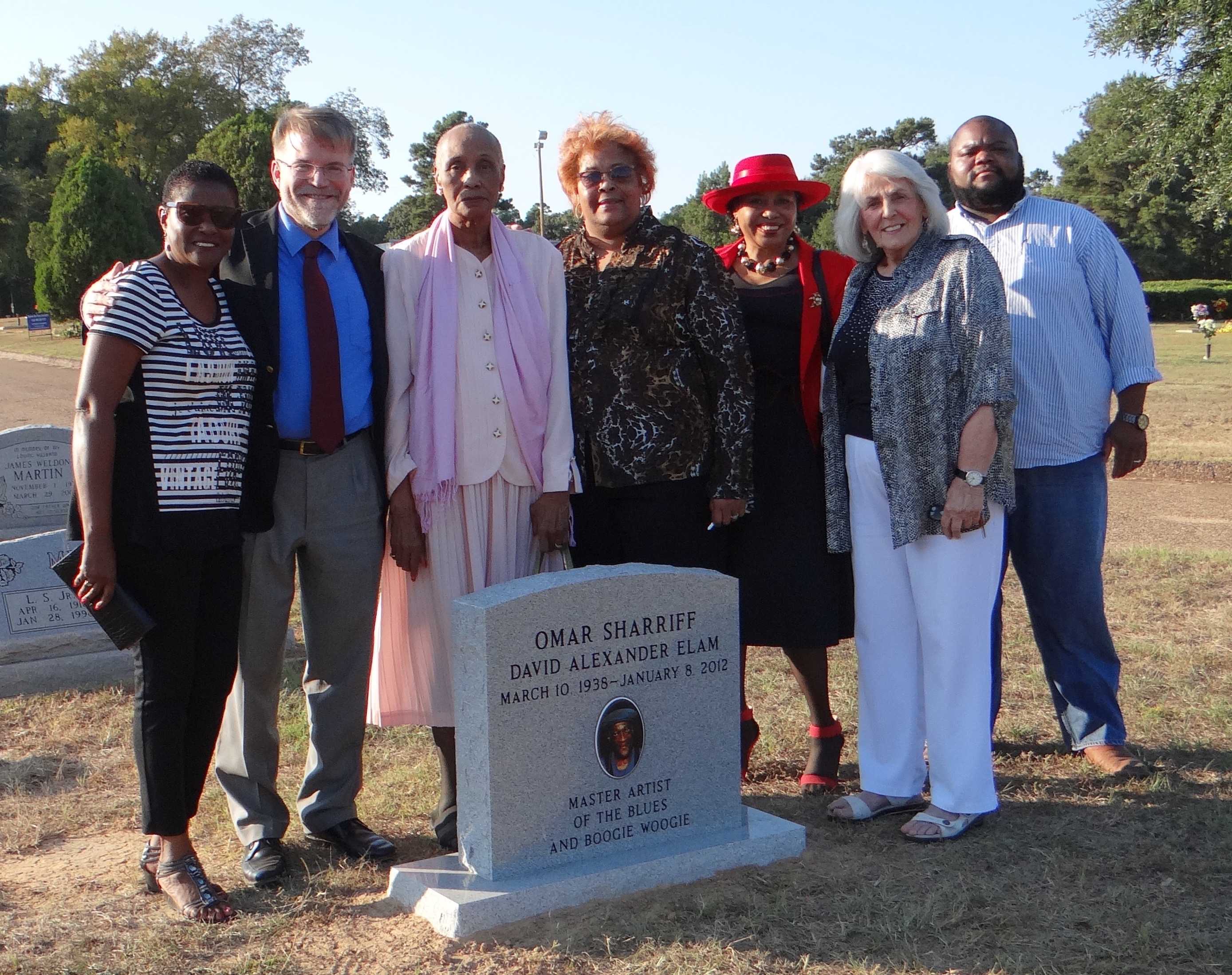
from left to right: Commissioner Vernia Calhoun, John Tennison, MD, Mrs. Charles Wilson, Commissioner Gloria Moon, Ms. (first name?) McIntosh, Donna Barr, and Commissioner LaDarius Carter
The headstone reads:
OMAR SHARRIFF
DAVID ALEXANDER ELAM
MARCH 10, 1938 -- JANUARY 8, 2012
MASTER ARTIST
OF THE BLUES
AND BOOGIE WOOGIE
The "Boogie Woogie Benefit Ball -- Tribute to Omar Sharriff" was held in Marshall, Texas, on Saturday, March 24, 2012, at Charlie's Backyard Bar.
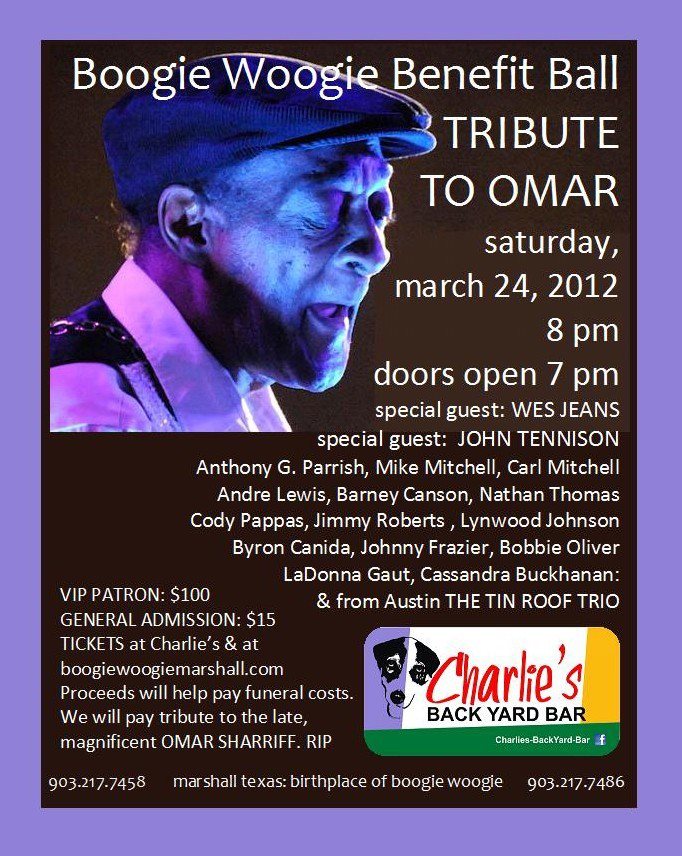
Proceeds from this March 24, 2012 concert were used to pay the funeral expenses for Omar Sharriff. Another concert is planned for August of 2012 to raise funds for a tombstone at the grave site of Omar Sharriff.
Obituary for Omar Sharriff, Published in the Marshall News Messenger, January 14, 2012
Comments Made by John Tennison, M.D. at Omar Sharriff’s Memorial Tribute, January 14, 2012
Comments Made by Wes Jeans at Omar Sharriff's Memorial Tribute, January 14, 2012
Concert Posters from Past Dave Alexander (AKA Omar Sharriff) Performances
R.I.P. Omar Sharriff (A.K.A. David Alexander Elam)
(born March 10, 1938, died January 8, 2012)